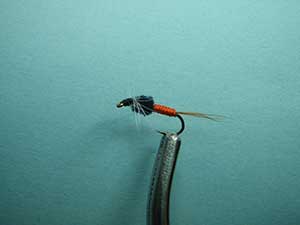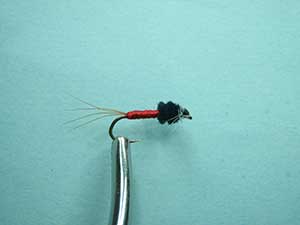Carrot Nymph


Rube Cross
Translated by CARL WUEBBEN
Rube Cross remains a legendary fly tier among catskill anglers. Living from 1896 to 1958, his flies and tying methods are still discussed and emulated. Although he was better known for his sparsely tied dry flies, like all master anglers, cross also tied and fished nymphs. The original name for the fly was the Carrot Ant Black Nymph, which was more commonly called the Carrot Nymph. Orange bodied wet flies have always been favorite patterns and the Carrot Nymph is an easy-to-tie pattern that is a good choice if you want to experiment with an orange nymph or wet fly. Leave the full hackle collar if you’d like to tie it a dry fly, or trim the hackle on the top and bottom to create a pattern with the profile of a nymph.
PATTERN
HOOK – Mustad 9671 or equivalent, size #14 to #12
THREAD – Black 6/0
TAIL – Brown hackle fibers
ABDOMEN– Carrot floss (orange) or dubbing
THORAX – Black chenille (Standard)
HACKLE – Dun hen soft hackle, clipped on the top and bottom
HOW TO TIE
- Debarb hook – mount in the vise – Start the thread at about half way down the shank and make a thread base to the bend of the hook, now tie in your tail (one hook shank long) using about four or five brown hackle fibers and wrap the butt ends down on the shank with close wraps so your abdomen will be very smooth then bring your thread back to the rear of the hook shank. Clip off your tag ends of the hackle fibers .
- Tie in your floss then with close wraps bring your thread forward to a little past mid shank . Tie off and clip off the tag end of the floss. TIP= Twist the floss a bit to keep it together and you won’t have any gaps when you wrap it forward
- Now tie in some black chenille and wrap forward to about one and a half an eyelets space from the eye of the hook. Tie off and clip off the tag end of chenille.
- Select a hen feather with fibers one and a half the gape size and tie it in front of the chenille, then wrap it forward about two or three times and tie off and clip your tag end off ( leave enough space behind the hook eye to make a small head).
- Make a small head – whip finish and clip your thread. Add a little head cement to the thread head – then trim the hackle on the top and bottom leaving the fibers hanging to the side.
Try it in different color bodies also
TIE UP A DOZEN OR TWO – AND GO FISHING*** But remember to practice C.P.R. (CATCH – PICTURE – RELEASE).



